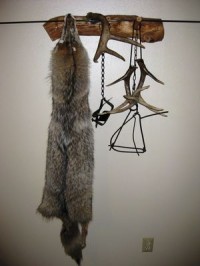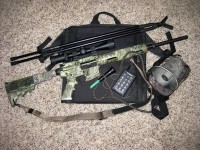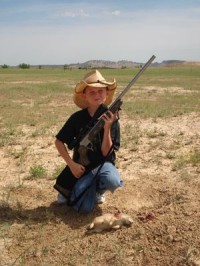Well, the 2008-09 predator hunting season is in the books for me this year. I hunted pretty consistently from mid – December until mid – March, with the loss of snow being a limiting factor in the last few weeks. Overall, I guess I’m pretty happy with this year’s results and thought I’d take some time to think about what made this year more
productive than the last few. Like any other type of hunting I think the best advice is to spend time in the field listening, observing, and experimenting. Here are a few things that I discovered.
 In my first couple of years of coyote hunting I was pretty hesitant to try any different sounds to change things up. This year instead of having one or two primary sounds that I would utilize on my electronic call I used about six or seven sounds pretty consistently. The sounds ranged from the good ‘ol rabbit distress to various coyote vocalizations. Many times I tried using multiple sounds during the same stand taking the advice of the Master, Randy Andersen, trying to create a type of scenario to pique the coyote’s curiousity and hopefully draw them into range. I plan on continuing to experiment with sound selection and hope to add even more sounds to the library for next year. It never hurts to mix things up a little bit.
In my first couple of years of coyote hunting I was pretty hesitant to try any different sounds to change things up. This year instead of having one or two primary sounds that I would utilize on my electronic call I used about six or seven sounds pretty consistently. The sounds ranged from the good ‘ol rabbit distress to various coyote vocalizations. Many times I tried using multiple sounds during the same stand taking the advice of the Master, Randy Andersen, trying to create a type of scenario to pique the coyote’s curiousity and hopefully draw them into range. I plan on continuing to experiment with sound selection and hope to add even more sounds to the library for next year. It never hurts to mix things up a little bit.
 I also did quite a bit of experimenting with different types of shooting sticks and strategies to prepare for shots that could come from virtually anywhere, at any time. What I finally decided was that I let the cover and the situation dictate whether or not I would keep my gun on the shooting sticks for each particular stand. Out of habit I would often get set up to call, set my gun on the bipod, and start the set. I got burned several times at the beginning of the year by having my gun on a bipod that clipped onto my gun versus just laying in a yoke attached to the bipod which allowed me faster shooting options. I remedied the problem by retrofitting a v-shaped yoke to the top of my Stoney Point Rapid Pivot bipod and I’m very happy with the results.
I also did quite a bit of experimenting with different types of shooting sticks and strategies to prepare for shots that could come from virtually anywhere, at any time. What I finally decided was that I let the cover and the situation dictate whether or not I would keep my gun on the shooting sticks for each particular stand. Out of habit I would often get set up to call, set my gun on the bipod, and start the set. I got burned several times at the beginning of the year by having my gun on a bipod that clipped onto my gun versus just laying in a yoke attached to the bipod which allowed me faster shooting options. I remedied the problem by retrofitting a v-shaped yoke to the top of my Stoney Point Rapid Pivot bipod and I’m very happy with the results.
 The last thing that I discovered this year is that coyotes will sometimes take a while to respond to the call. In the past I always stayed at stands for about 20 minutes which is what I had always read in various publications. On at least three occassions I had coyotes respond to the call 30 – 35 minutes after I started calling. On the hunt I titled “Last Minute Yote”, I remember thinking about wrapping up the set but decided that I was pretty comfortable sitting in my Crazy Creek chair and that I would just hang out and watch the landscape for awhile. Sticking around paid off in that case and I ended up shooting a nice female ‘yote that night.
The last thing that I discovered this year is that coyotes will sometimes take a while to respond to the call. In the past I always stayed at stands for about 20 minutes which is what I had always read in various publications. On at least three occassions I had coyotes respond to the call 30 – 35 minutes after I started calling. On the hunt I titled “Last Minute Yote”, I remember thinking about wrapping up the set but decided that I was pretty comfortable sitting in my Crazy Creek chair and that I would just hang out and watch the landscape for awhile. Sticking around paid off in that case and I ended up shooting a nice female ‘yote that night.
Hopefully this was helpful to a few of you who are getting into calling predators and if anyone has any great tips or tactics feel free to share. I try to write myself a few notes and the end of each season as a means of keeping records and to also help keep me from making the same mistakes twice. In the off season I’ll be working on stocking up on reloads for next year and keeping the guns dialed in by getting plenty of practice at the range as well as a Prairie Dog shoot with my son in June. Good luck to all on your future hunts…
2008-09 Predator Season Results
Coyotes Called – 16
Fox Called – 1
Coyotes Killed – 9
Coyotes Missed by me – 5
Coyotes Missed by partner – 2
Author: Jeff Hansen (aka: str8shooter )
Posted via: